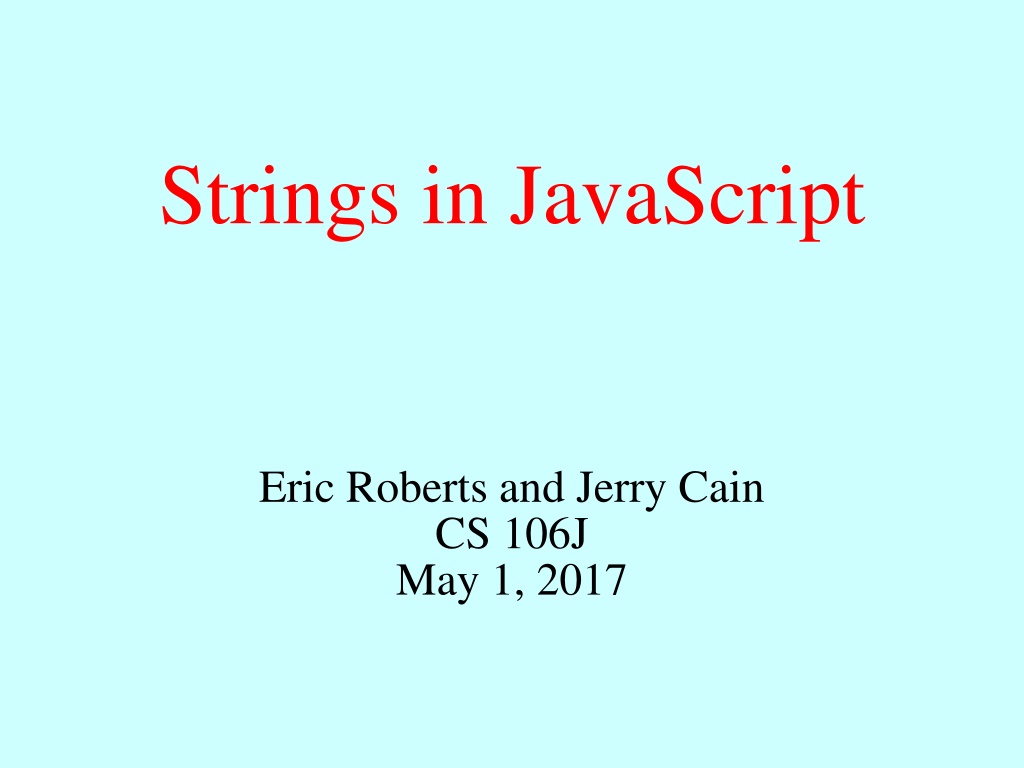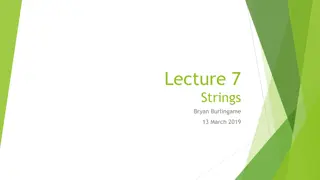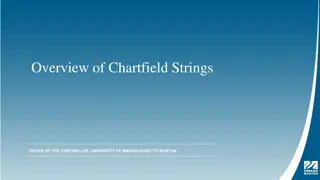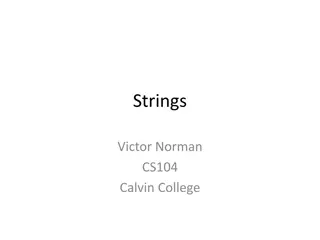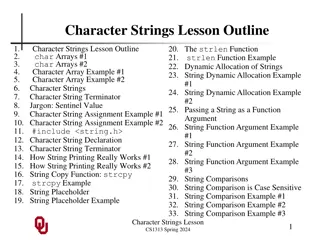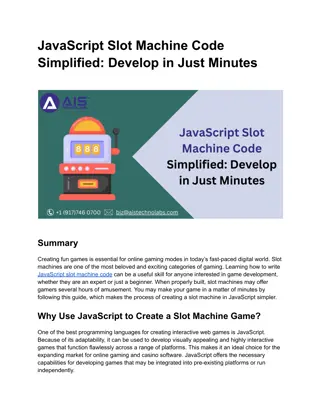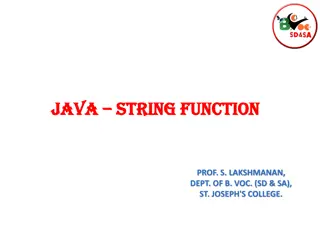Strings in JavaScript
Character encodings have evolved from Morse code to modern string operations in JavaScript. Explore the historical significance of early encodings and how they paved the way for today's communication methods. Discover how the invention of the telegraph led to social phenomena akin to the modern Internet, as detailed in "The Victorian Internet" book by Tom Standage.
Download Presentation

Please find below an Image/Link to download the presentation.
The content on the website is provided AS IS for your information and personal use only. It may not be sold, licensed, or shared on other websites without obtaining consent from the author. Download presentation by click this link. If you encounter any issues during the download, it is possible that the publisher has removed the file from their server.
E N D
Presentation Transcript
Strings in JavaScript Eric Roberts and Jerry Cain CS 106J May 1, 2017
Early Character Encodings The idea of using codes to represent letters dates from before the time of Herman Hollerith, as described in Chapter 6. Most of you are familiar with the work of Samuel F. B. Morse, inventor of the telegraph, who devised a code consisting of dots and dashes. This scheme made it easier to transmit messages and paved the way for later developments in communication. Samuel Morse (1791-1872) Alphabetic Characters in Morse Code
The Victorian Internet What you probably don t know is that the invention of the telegraph also gave rise to many of the social phenomena we tend to associate with the modern Internet, including chat rooms, online romances, hackers, and entrepreneurs all of which are described in Tom Standage s 1998 book, The Victorian Internet.
Review: Strings as an Abstract Idea Characters are most often used in programming when they are combined to form collections of consecutive characters called strings. As you will discover when you have a chance to look more closely at the internal structure of memory, strings are stored internally as a sequence of characters in sequential memory addresses. The internal representation, however, is really just an implementation detail. For most applications, it is best to think of a string as an abstract conceptual unit rather than as the characters it contains. JavaScript emphasizes the abstract view by defining a built-in string type that defines high-level operations on string values.
Using Methods in the String Class JavaScript defines many useful methods that operate on strings. Before trying to use those methods individually, it is important to understand how those methods work at a more general level. Because strings are objects, JavaScript uses the receiver syntax to call string methods. Thus, if str is a string, you would apply the method nameusing str.name(arguments). None of the methods in JavaScript sString class change the value of the string used as the receiver. What happens instead is that these methods return a new string on which the desired changes have been performed. Classes that prohibit clients from changing an object s state are said to be immutable. Immutable classes have many advantages and play an important role in programming.
Selecting Characters from a String Conceptually, a string is an ordered collection of characters. In JavaScript, the character positions in a string are identified by an index that begins at 0 and extends up to one less than the length of the string. For example, the characters in the string "hello,world" are arranged like this: h e l l o , w o r l d 0 1 2 3 4 5 6 7 8 9 10 11 You can obtain the number of characters by checking the length property, as in str.length. You can select an individual character by calling charAt(k), where k is the index of the desired character. The expression str.charAt(0); returns the one-character string "h" that appears at index 0.
Concatenation One of the most useful operations available for strings is concatenation, which consists of combining two strings end to end with no intervening characters. As you know from earlier in the quarter, concatenation is built into JavaScript in the form of the + operator. It is also important to recall that JavaScript interprets the + operator as concatenation only if at least one of the operands is a string. If both operands are numbers, the + operator signifies addition.
Extracting Substrings The substring method makes it possible to extract a piece of a larger string by providing index numbers that determine the extent of the substring. The general form of the substring call is str.substring(p1,p2); where p1 is the first index position in the desired substring and p2 is the index position immediately following the last position in the substring. As an example, if you wanted to select the substring "ell" from a string variable str containing "hello, world" you would make the following call: str.substring(1,4);
Comparing Strings JavaScript allows you to call the standard relational operators to compare the values of two strings in a natural way. For example, if s1 and s2 are strings, the expression s1 === s2 is true if the strings s1 and s2 contain the same characters. String comparisons involving the operators <, <=, >, and >= are implemented in a fashion similar to traditional alphabetic ordering: if the first characters match, the comparison operator checks the second characters, and so on. Characters are compared numerically using their Unicode values. For example, "cat">"CAT" because the character code for "c" (99) is greater than the code for "C" (67). This style of comparison is called lexicographic ordering.
Searching in a String The method indexOf takes a string and returns the index within the receiver at which the first instance of that string begins. If the string is not found, indexOf returns -1. For example, if str contains the string "hello,world": 0 4 1 returns returns returns returns -1 str.indexOf("h") str.indexOf("o") str.indexOf("ell") str.indexOf("x") The indexOf method takes an optional second argument that indicates the starting position for the search. Thus: 8 str.indexOf("o",5) returns The lastIndexOf method works similarly except that it searches backward from the end of the receiving string.
Other Methods in the String Class String.fromCharCode(code) Returns the one-character string whose Unicode value is code. charCodeAt(index) Returns the Unicode value of the character at the specified index. toLowerCase() Returns a copy of this string converted to lower case. toUpperCase() Returns a copy of this string converted to upper case. startsWith(prefix) Returns true if this string starts with prefix. endsWith(suffix) Returns true if this string starts with suffix. trim() Returns a copy of this string with leading and trailing spaces removed.
Exercise: Implementing endsWith The startsWith and endsWith methods did not exist in early versions of JavaScript. The text includes an implementation of startsWith written as a client function. How would you do the same for endsWith?
Simple String Idioms When you work with strings, there are two idiomatic patterns that are particularly important: 1. Iterating through the characters in a string. for (var i = 0; i < str.length; i++){ var ch = str.charAt(i); . . . code to process each character in turn . . . } 2. Growing a new string character by character. var result = ""; for (whatever limits are appropriate to the application){ . . . code to determine the next character to be added . . . result += ch; }
Reversing a String str "stressed" str result "dess" "desse" "desser" "dessert" "desserts" result i i "" "d" "de" "des" 7 6 5 4 3 2 1 0 -1 > reverse("stressed") desserts >
Exercise: Implementing toUpperCase Suppose that the toUpperCase method did not exist. How would you implement a toUpperCase function that returns the same result?
The GLabel Class You can display a string in the graphics window using the GLabel class, as illustrated by the following function that displays the string "hello,world" on the graphics window: function HelloWorld() { var gw = GWindow(GWINDOW_WIDTH, GWINDOW_HEIGHT); var label = GLabel("hello,world", 100, 75); label.setFont("SansSerif-36"); label.setColor("Red"); gw.add(label); } HelloWorld hello, world
Operations on the GLabel Class Function to create a GLabel GLabel(text,x,y) Creates a label containing the specified text that begins at the point (x, y). Methods specific to the GLabel class label.setFont(font) Sets the font used to display the label as specified by the font string. The font is typically specified as a string in the form "family-style-size" where family is the name of a font family style is either PLAIN, BOLD, ITALIC, or BOLDITALIC size is an integer indicating the point size
The Geometry of the GLabel Class The GLabel class relies on a set of geometrical concepts that are derived from classical typesetting: The baseline is the imaginary line on which the characters rest. The origin is the point on the baseline at which the label begins. The height of the font is the distance between successive baselines. The ascent is the distance characters rise above the baseline. The descent is the distance characters drop below the baseline. You can use the getHeight, getAscent, and getDescent methods to determine the corresponding property of the font. You can use the getWidth method to determine the width of the entire label, which depends on both the font and the text. QuickBrownFox The quick brown fox jumps over the lazy dog. origin ascent baseline height descent
